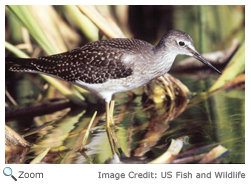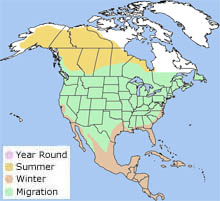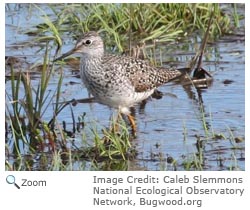Characteristics
 The lesser yellowlegs is a medium sized shorebird that is nine to ten inches in length. It has a long, straight bill; a long neck; and a speckled brown body with a white belly and a gray rump. It gets its name from its very long, bright yellow legs. Males and females look alike. The lesser yellowlegs is a medium sized shorebird that is nine to ten inches in length. It has a long, straight bill; a long neck; and a speckled brown body with a white belly and a gray rump. It gets its name from its very long, bright yellow legs. Males and females look alike.
Range
 The lesser yellowlegs breeds
across Alaska and northern Canada eastward to western Quebec and it winters in the southern United States southward to southern South America and northward along the coasts to southern central California and New Jersey. The lesser yellowlegs breeds
across Alaska and northern Canada eastward to western Quebec and it winters in the southern United States southward to southern South America and northward along the coasts to southern central California and New Jersey.
Habitat
 The lesser yellowlegs spends the breeding season in grassy meadows, bogs, burned out forest areas and other open areas or natural clearings. During migration and the winter, it can be found along the shores of lakes and rivers, in marshy ponds and in coastal marshes and mudflats. The lesser yellowlegs spends the breeding season in grassy meadows, bogs, burned out forest areas and other open areas or natural clearings. During migration and the winter, it can be found along the shores of lakes and rivers, in marshy ponds and in coastal marshes and mudflats.
|
|
Diet
 The lesser yellowlegs forages for food by pecking and grabbing up prey from shallow water. It will also chase prey on land. It eats a wide variety of insects and invertebrates including ants, flies, grasshoppers, insect larvae, crustaceans, mollusks and worms. It also eats small fish and seeds. The lesser yellowlegs forages for food by pecking and grabbing up prey from shallow water. It will also chase prey on land. It eats a wide variety of insects and invertebrates including ants, flies, grasshoppers, insect larvae, crustaceans, mollusks and worms. It also eats small fish and seeds.
Life Cycle
The female lays four eggs in a depression in the ground at the base of a tree stump, under a small bush or in a brush pile. Nests are made in an open area near water and are lined with bits of leaves and grass. The female may nest alone or in a small colony. The chicks hatch in 22-23 days and fledge when they are 18-20 days old. The chicks are precocial and can catch their own prey within hours of hatching. They are cared for by both parents and leave the nest shortly after hatching. The female will sometimes leave the chicks before they can fly, leaving the male to care for them until they fledge.
Behavior
 The lesser yellowlegs is a relatively tame bird and will allow intruders to approach at close distances. It was once a popular game bird but is now protected. The lesser yellowlegs is a relatively tame bird and will allow intruders to approach at close distances. It was once a popular game bird but is now protected.
|